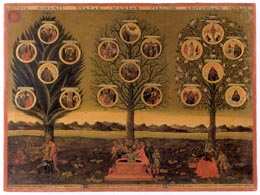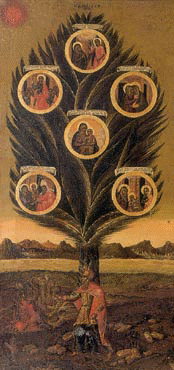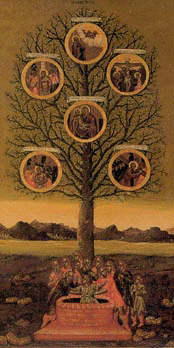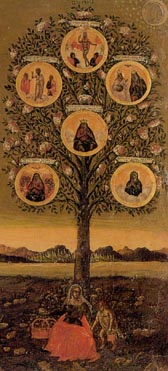Rosary Painting of 15 Mysteries
Rosary Painting of 15 Mysteries
A Rosary Painting
In 2003 the Marian Library had the privilege to offer to friends and visitors thirty-eight Marian artworks from the Vatican Museums dating from the fourth century to the twentieth century. The following painting was part of the display. It deals with the rosary.

The Mysteries of the Rosary, artist unknown, late sixteenth century, early seventeenth century, Oil on panel Vatican Pinacoteca (Inv. 41409)
General Description: The Latin inscription on top of the panel characterizes this painting as “the threefold devout contemplation of the Rosary of the Blessed Virgin Mary.” The Rosary had traditionally fifteen mysteries or events of the lives of Jesus and Mary. The mysteries are grouped in three series: the joyful, the sorrowful, and the glorious mysteries.
The painting shows a broad landscape. In the foreground it is subdivided by three large trees. Attached to each tree are medallions or tondos representing the mysteries of the Rosary. At the foot of each tree is shown an episode of the Old Testament. The landscape is further subdivided by three native scenes: the verdant field with trees, a body of water, and a chain of mountains with silhouettes of towns with tiny domes and spires.
The painter is unknown, but it is believed that he was Greek, and familiar with both Byzantine and Western traditions of painting. The painting reflects Italian-Cretan icon style (medallions) as well as Western stylistic elements (Venetian landscapes). The colors are strong and glazed in hues of red, blue, brown, and ocher. Faces and silhouettes are diminutive and dark, enlivened by highlights.
The Three Trees convey the central message of this painting, which has a pronounced educational character. It informs about the Rosary and its meaning. Its goal is to lead to “devout contemplation.”

The Palm Tree introduces to the joyful mysteries. The palm is a symbol of glory. In Christian tradition, it stands for the victory of Christ over death. It suggests Resurrection and Immortality.
Each of the circular images attached to the branches represents one of the five joyful mysteries. There is a sixth medallion, which summarizes the overall meaning of the five joyful mysteries.
1. The Annunciation (The Angel Gabriel announces to Mary the birth of Christ) (Luke 1:38)
2. The Visitation of Mary with her cousin Elizabeth (Luke 1:42)
3. The Nativity of Jesus (Luke 1:48)
4. The Presentation of Jesus in the Temple (Luke 2:29)
5. Christ among the Doctors (Luke 2:49)
6. The sixth and central image (Madonna with Child) represents Mary’s divine maternity and the Incarnation of Christ which is the beginning of Redemption and Resurrection for all of good will. This is the central meaning of the joyful mysteries.
The Old Testament scene at the foot of the Palm Tree is from Exodus (15:1). Moses raises his staff after crossing the Red Sea, and closes the passage, drowning the Egyptian army. The scene announces the power of God, which finds its lightest expression in the coming of his son.

The Blackberry Bush (center) introduces us to the sorrowful mysteries. The blackberry bush with its thorns is a symbol of suffering and death. Its branches laden with thorns enclose the mysteries and events of Jesus’ passion and death. Beginning at the top, the medallions show.
1. Jesus praying in the Garden (Luke 22:42)
2. The Flagellation (Psalm 72:14)
3. The Crowning with Thorns (Ezekiel 24:17)
4. Christ bearing the Cross (Matthew 16:24)
5. The Crucifixion (John 19:26)
The central tondo represents the Pietà emphasizing the deep sorrow of the Mother holding her son in her arms. The sorrowful mysteries lead us to the contemplation of Christ’s death, a death suffered for the redemption of all.
The scene at the foot of the blackberry bush pictures Joseph thrown into the well by his brothers (Psalm 118:12). Joseph is a symbol of Christ. The scene anticipates Christ’s burial, and Joseph’s brothers are reminiscent of Christ’s persecutors. Psalm 118 already announces Christ’s victory over sin and death.

The large Rose Bush is adorned with red and white roses. The rose is a traditional symbol of Mary and of the Rosary. Red stands for love, white for virginity (S. Bernard). The two colors are also metaphors of charity and purity. The rose bush represents the third series of Rosary mysteries, the glorious mysteries. These begin with the Resurrection of Christ, and end with the Coronation of Mary.
1. The Resurrection of Jesus (Psalm 3:6)
2. The Transfiguration of Jesus (instead of the Ascension) (Matthew 17:9)
3. Pentecost, showing Mary in the midst of the Apostles (6) (Wisdom 1:7)
4. The Assumption of the Blessed Virgin Mary (Sirach 24:19)
5. The Coronation of the Virgin by the Father (Canticle 4:7)
The medallion at the center shows Mary with a crown on her head. She is the crowning of Christ’s work of salvation. She is the all-beautiful one and represents the fulfillment of all in eternity.
The scene at the foot of the rose bush shows the personification of wisdom that is Mary, Seat of Wisdom and Tabernacle of the Eternal Word. The baskets filled with flowers symbolize the gifts of wisdom. Mary offers fruit and flowers, the gift of wisdom, to the poor (Sirach 14:12).
Three Images of Mary: The threefold rosary of joyful, sorrowful, and glorious mysteries can be summarized in the three central representations of Mary:
Mother of Jesus Christ (joyful mysteries)
Pietà (sorrowful mysteries)
Madonna Queen (glorious mysteries)
Each of these images can only be rightfully understood in relation to Jesus Christ. He is the Incarnate Word, the Redeemer, and Ultimate fulfillment of human life. Mary embodies the human side of salvation history: she receives Jesus (Mother), accompanies him to the end (Pietà), and receives eternal glory from God’s hand (Queen).
Interesting Iconographical Motifs:
1) Blue and Red: Mary’s vestments are traditionally red and blue. In the joyful mysteries her cape is blue, and her garment red. Red stands here for Mary’s Assumption into heaven.
2) Sun and Moon: Popular in medieval representations of the crucifixion, sun and moon stress the cosmological or universal importance of redemption. They also point to Old (moon) and New Testament (sun). Sun and moon on the upper left and right corners of our painting may be a pictorial allusion to the rapport between Jesus and Mary: Mary (moon) receives her meaning and importance through Jesus (sun).
3) The “golden horns”: We can see two blazing rays on Moses’ forehead (see foot of the Palm tree). These are not “golden horns” (Ex. 34:29f) but rays of light that illuminate his face, a result of Moses’ encounter with God. An erroneous interpretation of the Vulgate made them into horns.
To learn more about the Rosary:
Ask for Rosary Markings, a pamphlet on the origins, the importance, and ways of praying the rosary.
Did you know that there are now four series of mysteries? The fourth was added in the fall of 2002 by Pope John Paul II in his encyclical letter on the Rosary.
Year of the Rosary, October 2002 - October 2003
All About Mary includes a variety of content, much of which reflects the expertise, interpretations and opinions of the individual authors and not necessarily of the Marian Library or the University of Dayton. Please share feedback or suggestions with marianlibrary@udayton.edu.
